I picked up the thin, nearly translucent shaving from the ground. It looked like a shaving of a fingernail. I examined it closely. I slowly did a rough calculation in my head. This little, tiny rhino horn shaving, no bigger than a dime, is probably worth $150. It’s hard to wrap your head around it – especially when the value is based on myths and not science. I thought about all of the lives lost, families ruined, and nature on its way to extinction; this little shaving of rhino horn comes with a whole lot of drama.
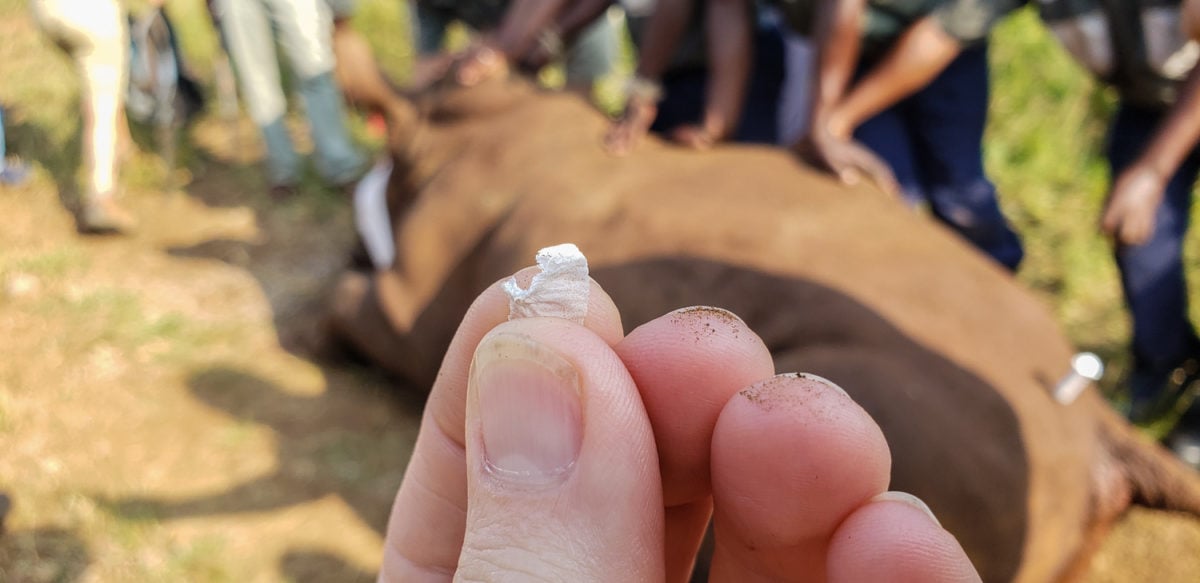
There are so many tragedies in the world today, I often put my head in the sand and try to just power through. I know that might not be the best way to deal with things, but I can’t digest and follow it all. However, when I do come into direct contact with an issue, I pull my head out of the sand and pay attention. That was my experience with the rhinos in South Africa. I had heard about rhino extinction and poaching in South Africa, but knew very little about it. Now here I was in South Africa at Thanda Safari, it was time for me to learn.
One could write a novel about the rhino crisis. However, my knowledge, and this article, is really based on my personal experiences during my time at Thanda Safari. This is what travel taught me about this crisis.
Table of Contents
Why are Rhinos Going Extinct?
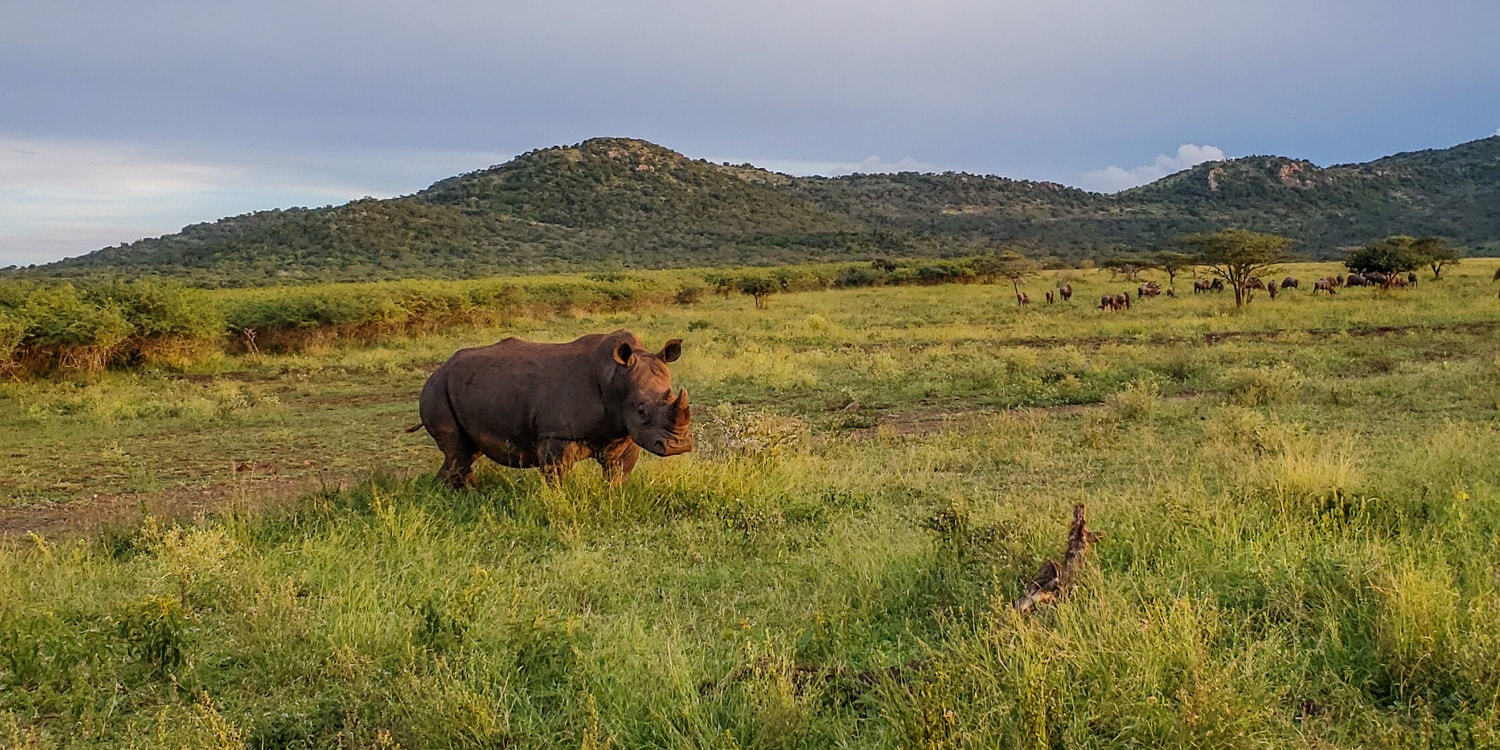
In the last decade, over 8,300 rhinos have been lost to poaching which has led to their critically endangered status. Like most things – it’s all about demand and supply. It is thought that rhino horns hold some sort of special powers. The powers are varied depending on the culture; makes you sexier, richer, luckier, cures cancer. East Asia, specifically Vietnam and China, is the largest market for rhino horns and drives the demand. All of the rhino horn supply is sitting in Africa and people are being paid incredible amounts of money to ‘harvest it’. This leads to the illegal poaching and subsequent killing of Rhinos all over the world.
How do you get a horn from an animal that is 5,100 lbs and could squash you like an ant? You kill it and then cut off the horn. It’s relatively fast and cheap to do so, if you have no conscience.
How a Reserve Tries to Protect Their Rhino Population
From January to April 2019, 45 rhinos were lost in the region around Thanda Safari to poachers. None were from Thanda, however surrounding areas/reserves were targeted. Once I learned this, I was wanted to know how reserves like Thanda are combating this.
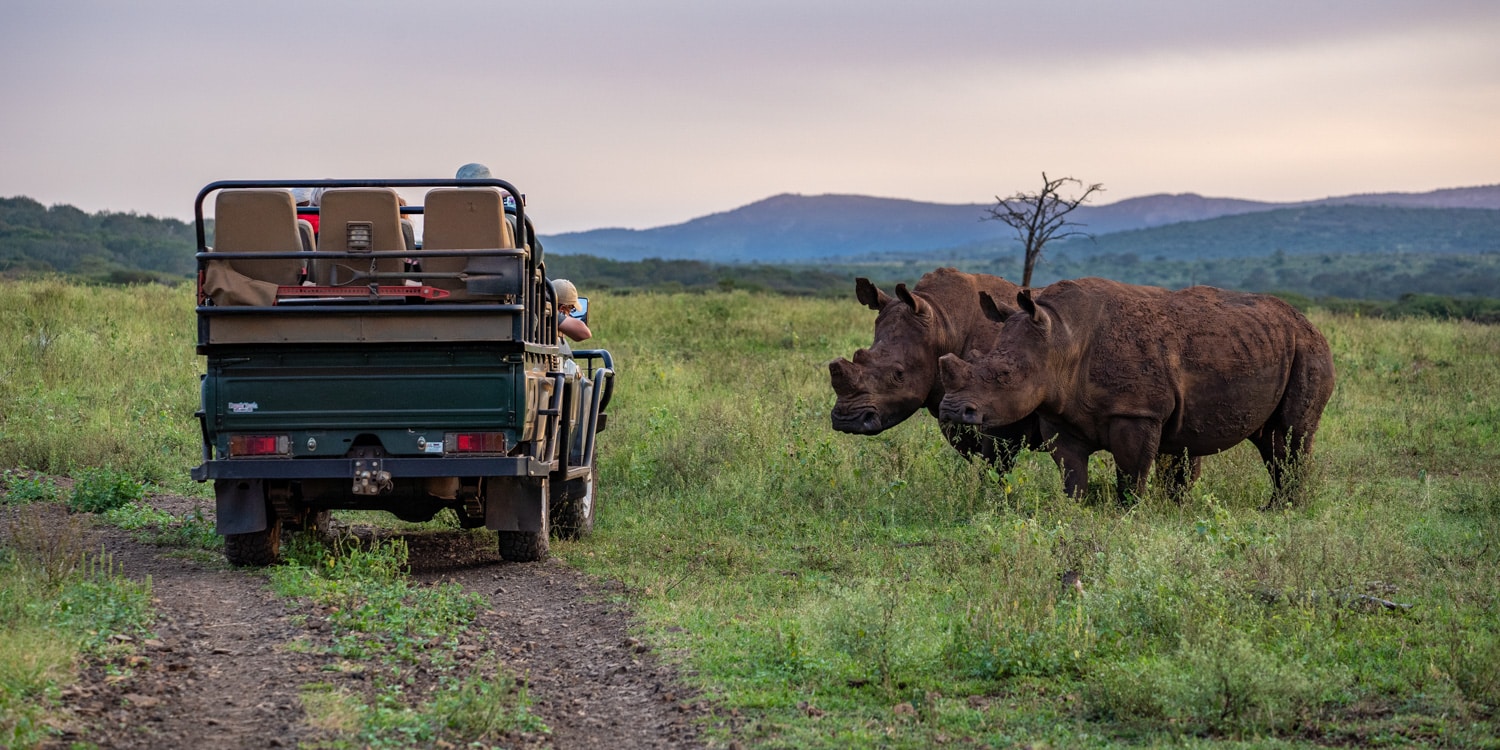
The Cost of Protecting Rhinos
According to Truman, Thanda’s Reserve Operations and Security Manager, ten years ago Thanda was spending 150,000 Rand ($9,800) a month on security. Currently they are spending 753 million Rand ($50,000) a month.
“It’s a war – you need to train yourself. The poachers will stop at nothing. When you encounter them, they will run for their lives. There are people every day that will risk their lives – that’s expensive,” explained Truman.
He went through the list of things that go into that monthly budget.
- Average salary for a field ranger is 6000 Ran ($400) a month. They have more than 30 field rangers.
- Technology costs (camera traps and drones).
- Need to secure and maintain the fence line.
- Need to dehorn every 2 years (more on this a little later).
Not only did it help me understand why safaris are so expensive, but it just left me wondering, how can budgets like this be sustained?
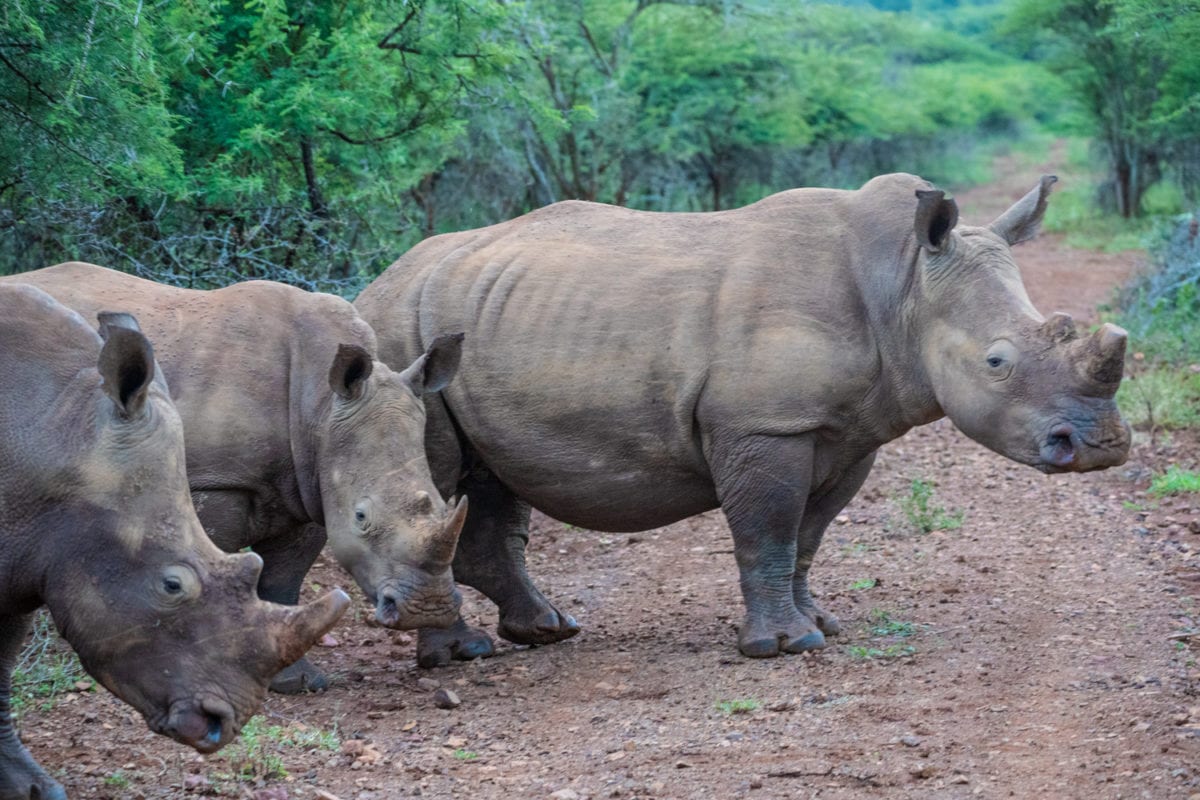
Anti-Poaching Team
As we drove around the park, occasionally I would see a couple of men in fatigues and rifles sitting in the shade under the trees. I came to learn that they were a part of Thanda’s anti-poaching team (APT). There was likely a rhino near there they were watching over.
Recognizing the importance of working from the inside out, Thanda created a separate team to watch over the rhinos. The APT keeps a book of where the rhinos are, often waiting for days for them to show up or watch over them. All of the rhinos are identified by an ear notch – something they can see from afar and identify them and their movement.
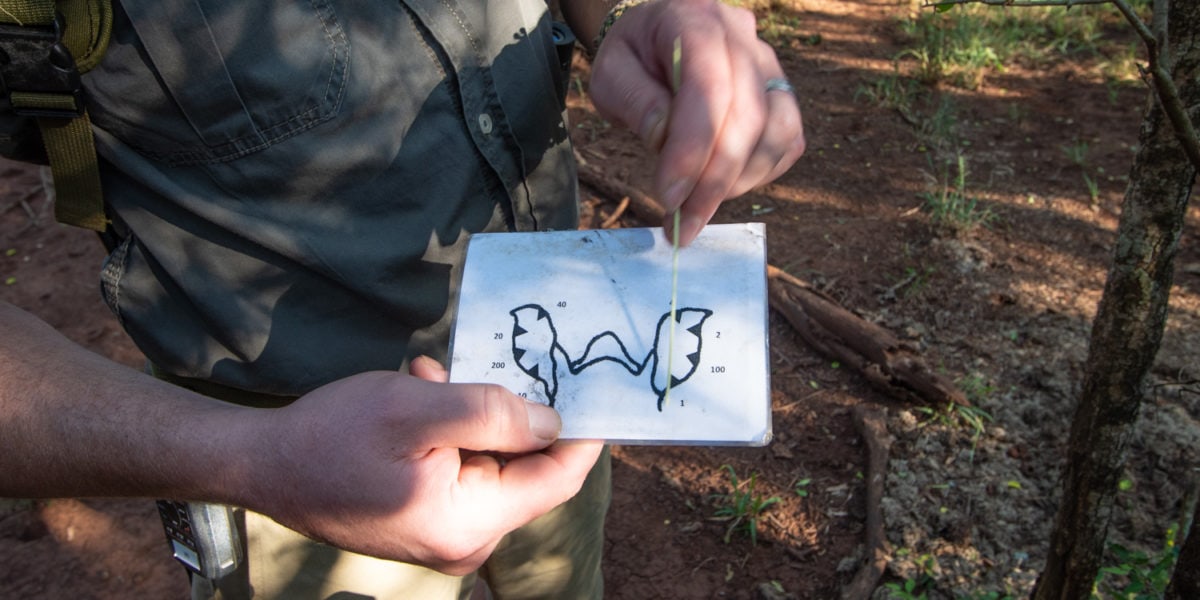
The Danger Within
I was surprised to learn that the poachers are often the community around the reserve, or even an employee at the reserve.
“I don’t blame the local people – I blame the people paying them,” Thanda’s wildlife coordinator Mariana tells me. “Often the local people don’t understand what they are really doing.”
I nod in agreement, it’s sad that the people who are really calling the shots and causing the crisis are likely preying upon people who don’t understand and need money so badly that they will do anything. Just like the drug trade in a way – throughout history this story keeps on playing out.
Thanda tries to combat this issue by concentrating on both their employees and the community. “You pay a good salary, treat them well. Know your community and educate them,” explained Truman.
Dehorning as a Way to Combat the Crisis
The first time I heard the term ‘dehorning’ I was in shock. It didn’t dawn on me why in the world a reserve would dehorn a rhino; it seems counter-intuitive. Here’s the important part I learned – horns grow back. Yes, that’s right, rhino horns are made of keratin – just like our fingernails and hair. You cut it and it grows back full in one to two years.
“We have started dehorning rhinos. I can tell you, as a man responsible in the reserve, I don’t know what dehorning a rhino will do to it 10 years down the road. All I know is that a rhino needs his horn to be intact. But I am forced to dehorn the rhino because I’m trying to reduce the reward to the poachers,” Truman explained with a visibly heavy heart. “If you remain an island and all of your neighbors are dehorning, then you become a target. The poachers will up their game.”
Since the parks around Thanda have all started dehorning, it has forced Thanda to do the same.
When you talk about dehorning, the first question I always get is, “Don’t rhinos need their horn for protection?”
I went to Mariana and asked her about this concern, “Adult rhinos don’t have any natural enemies other than humans,” she said. “We don’t just dehorn, we have a plan in place. If we know there are two bulls in the same area, we will dehorn them on the same day so that the one won’t be able to kill the other one if he doesn’t have his horn. Adult females are usually dehorned after the calf is a year old and then their horns grow back so she’ll be able to defend her next small calf.”
Experiencing a Rhino Dehorning First Hand
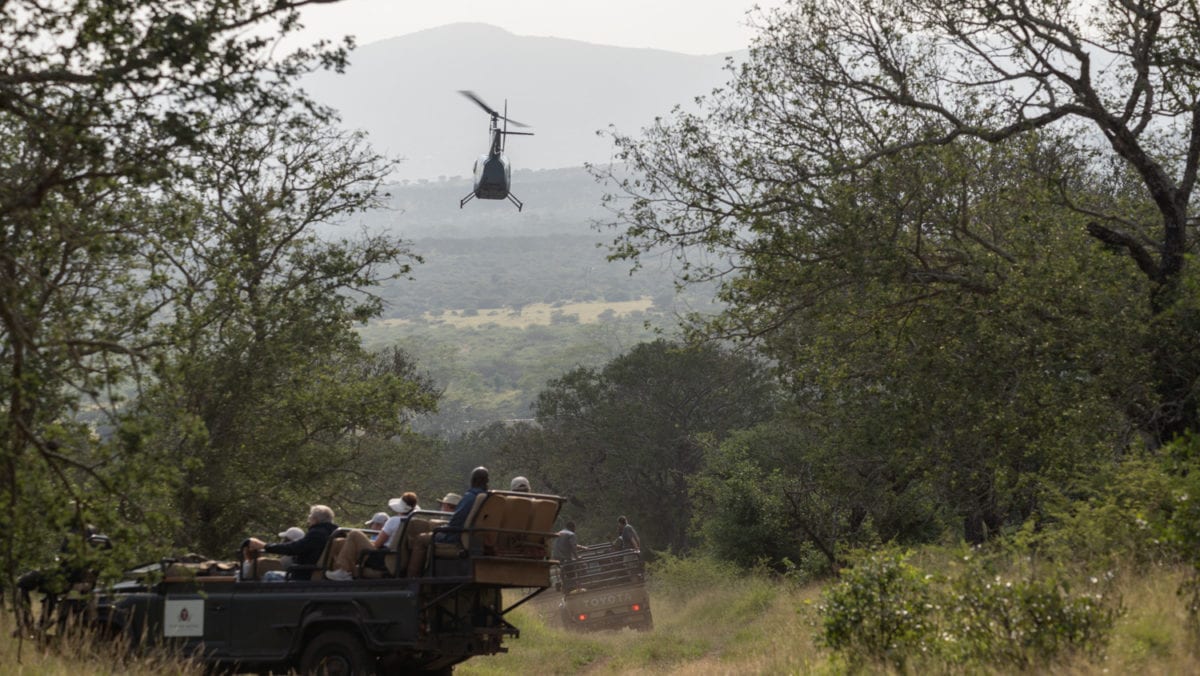
I watched the helicopter swerve around, hovering above the trees as if I were on some Mission Impossible movie set. The vet hangs out of the helicopter and takes aim. Next I hear a series of high-pitched horn noises used by the helicopter vet to herd the darted rhino out into the open. It takes about 5 to 10 minutes for the drug cocktail to take effect and the rhino passes out right in the middle of the road in perfect position. Once the rhino is secured with a blindfold and earplugs, we get the ‘ok’ to get out of our vehicle to watch and learn about the process.
Yes – you can really be a part of the dehorning process at Thanda. I was excited when the opportunity came up to be a part of it. I had opened up the flood gates of curiosity about rhino issues, and I wanted to understand everything I possibly could.
The Cost of Dehorning
To dart a rhino from a helicopter and do the procedure is quite expensive – around 27,500 Rand ($1,800). However, it’s the clients that normally pay for this. By offering this as an educational conservation experience to the safari clients, they are basically funding the conservation and get to be more involved.
“We aren’t trying to make money out of it – we are trying to cover the cost,” Mariana explains. “And if the vets work really fast – then they’ll dart another rhino for the same price.”
It’s not about the money – it’s more about the guests being involved.
Mariana continues, “I enjoy it more if people are there to learn. We have budget for these activities – but we can just do more when guests help fund it.”
It’s More Than Dehorning
They were dehorning a female rhino tagged C21. The dehorning is noisy and a bit violent to watch, but the vets and researchers tell us it is no more painful than trimming your fingernails if done correctly. In fact, the entire time from before the darting to the dehorning, the researchers and vets are explaining the process and everything they are doing. The growth plate is still in place and the horn will grow back. They also assure us there is no pain or discomfort due to the morphine dose. However, I’m not real sure how the rhino feels the next few days recovering from this weird alien encounter they just had.
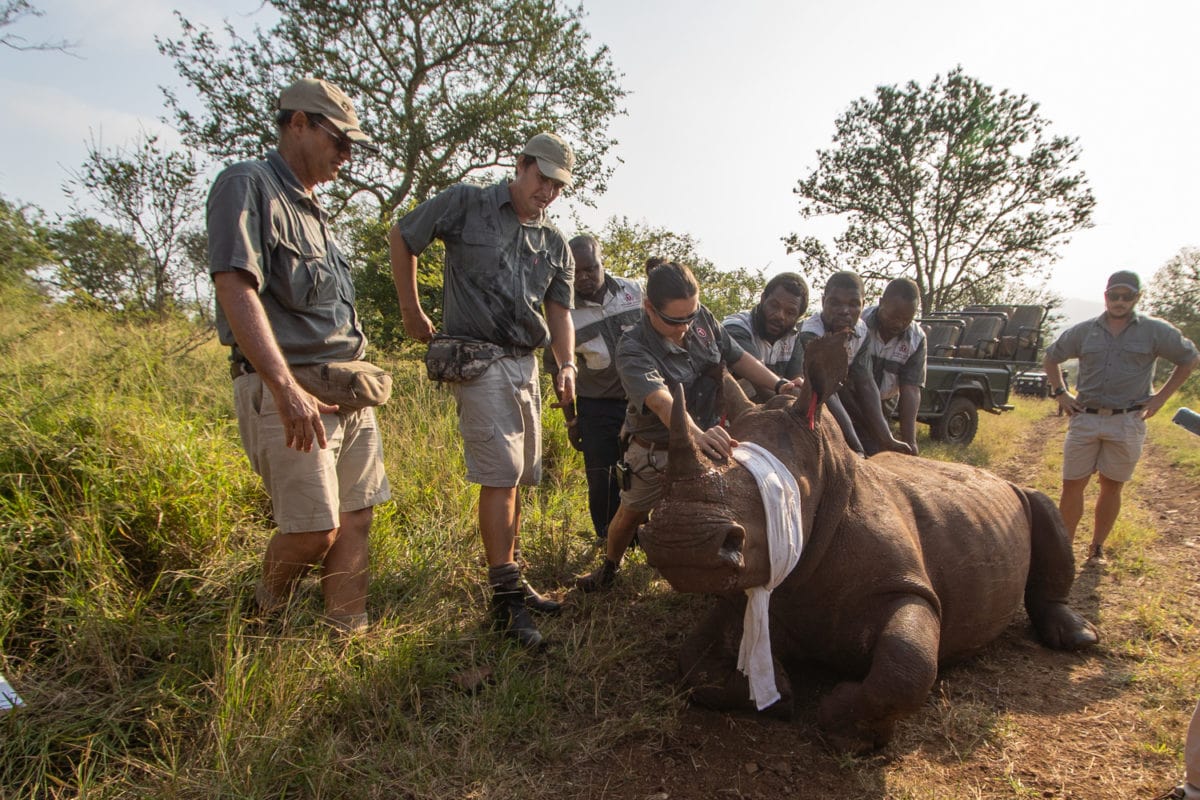
While the rhino is on morphine, they also do important things like cut a notch in its ear if it hasn’t already been done, take DNA samples, put in a microchip that links to DNA, and reviews its general health. The DNA is taken to help identify any rhino horn that turns up in Asia and aids in prosecution.
Close Up View
We were also able to get as close as we wanted and touch the rhino; her skin was tough like leather. One man in our group was even allowed to do the ear notching. As I had my hand on C21’s back, you do feel like you develop a bond with the giant wild animal. It was a moving process for me overall.
After the horn is removed, they buff it into a rounded shape. Little horn flakes were flying onto the ground. That’s when I picked it up to examine it closer. At $60,000 a kg, it is more valuable than gold. It felt weird to even touch it. C21’s removed horn was 800mg, a value of around $40,000 on the illegal black market.
“What do you do with the horn,” I asked.
“We cannot comment on this,” said Truman.
He went on to explain that at this stage the horn is valueless to the landowner. They take it away to a vault in secrecy and do not leave it at the reserve because it leaves everyone at risk – including the clients. It was then I decided that I didn’t really want to know where that horn went either.
Measuring the horn
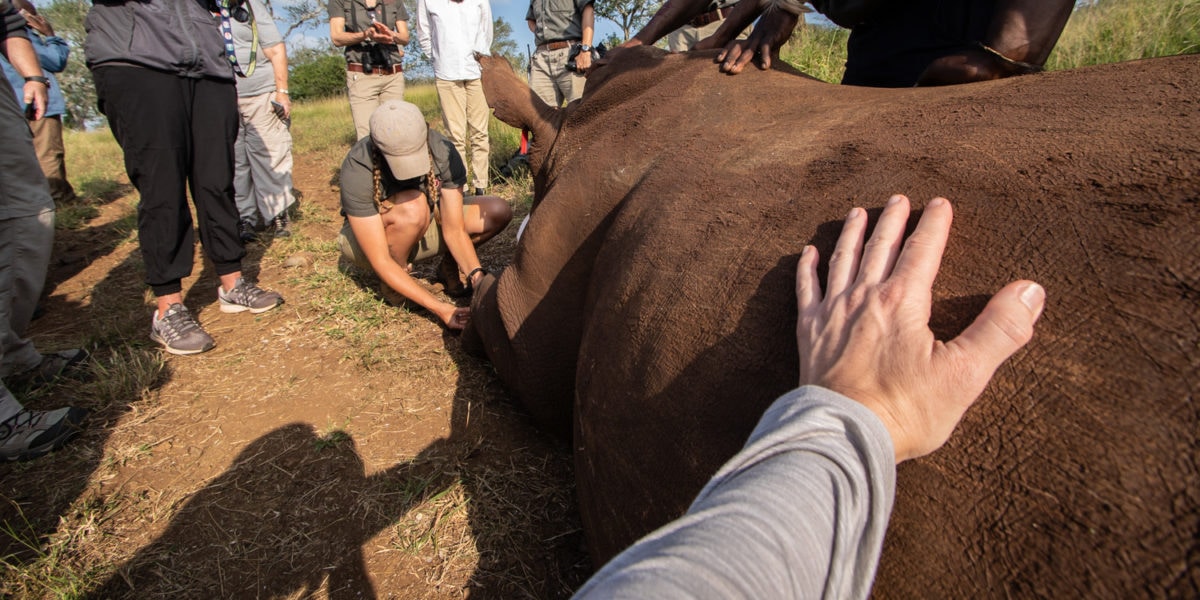
The whole dehorning experience with C21 was emotional for me, but the best part was when they gave the injection to wake C21 up. We watched from a distance as she came to and stumbled as if she were drunk. But in a short time, she got her bearings and bound back off into the bush as if nothing happened. I smiled as I saw that familiar rhino prance once again. I kept wondering though what was going through her mind; did she think she had been abducted by aliens? Did she miss her horn?
The helicopter flew off and the vets debriefed us letting us know that the stump would take about 3 weeks to heal completely and in a month regrowth would start to happen.
Are there any Answers to the Rhino Crisis?
Some say that legalization is the answer. The horn is a renewable resource since it grows back, and it could change the whole market dynamics if the horn was legal and the available to anyone. It’s free market supply side economics. It would also mean people would start farming rhinos just to harvest the horns.
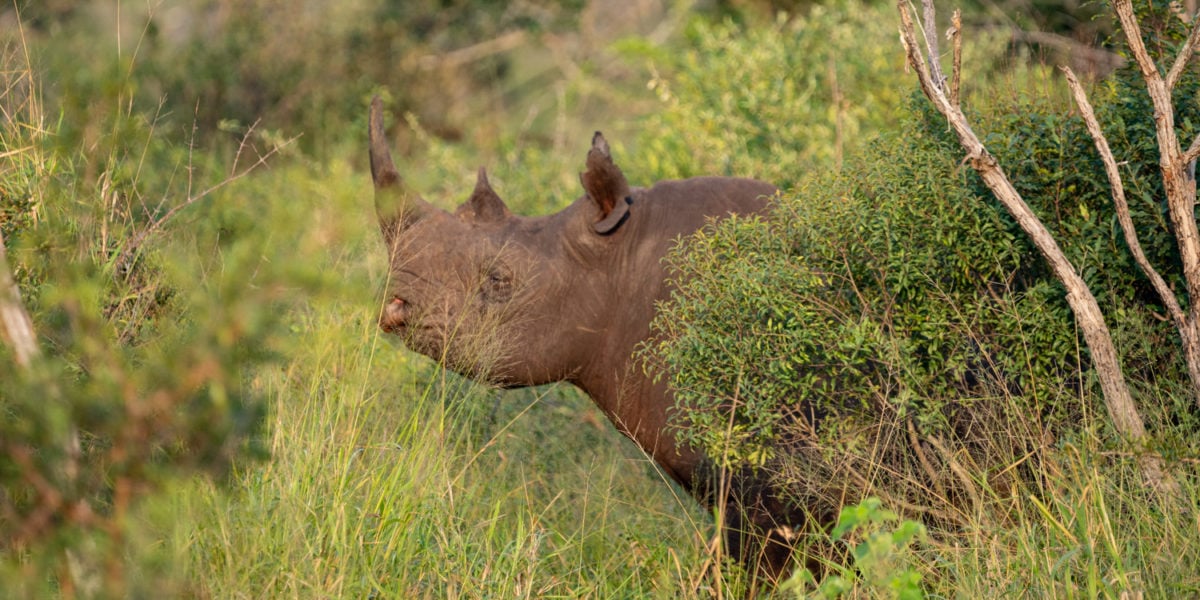
I understand the economics of this argument, but I’m not sure that it’s the answer. I recently attended a TEDx Mile High presentation in Denver and listened to Annecoos Wiersema talk about why legalization isn’t the answer. She’s a law professor & Associate Dean at the University of Denver who works in international wildlife law and illegal trade.
She questioned whether demand would really change if legalized. “Fads, like rhino horn, come and go; they aren’t predictable.”
Plus, she questioned whether consumers really would want farmed rhino horns. She believes they will want the wild version instead. “If you are someone who wants to consume tiger penis you will probably want the wild one,” she said.
You can see her complete talk here
After listening to her, I agree with her – there is no such thing as a magic fix.
Maybe Travel is the one of the Answers to Saving the Rhinos
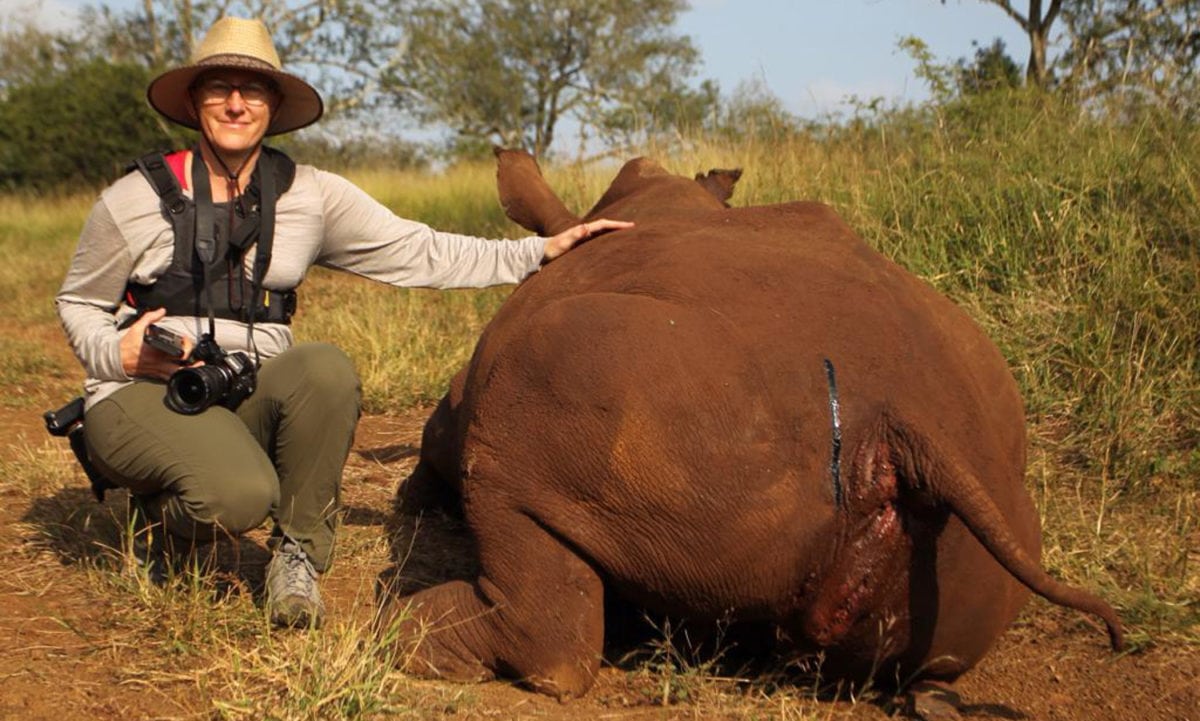
My time at Thanda was educational and eye opening – it was more than a vacation; it was about me obtaining first-hand knowledge about conservation. Simply seeing the prehistoric looking rhino in the wild is a transformative experience, and something future generations may not get to do. Going beyond that and doing a rhino tracking walking safari and also being able to see a dehorning, were my highlights; it made me understand the whole process and crisis better. I have no answers on what to do, but I understand the issue so much better because I was there for a week living it. It ignited me, much like my trip to the Ross Sea in Antarctica ignited me to no longer eat Chilean Sea Bass.
So maybe the real lesson here is if you want to help save the rhino – go see one. Travel is much more than simply a ‘break’ or pleasure – it’s an education. Travel may even help save the rhino so my nieces and their children can go see them too.
How you can learn more about Rhino Conservation at Thanda Safari
Thanda private game reserve offers multiple ways to experience the South African Rhino; game drives, walking safari, volunteering at Ulwazi, and dehorning. Thanda Safari Website Thanda Walking Safari Ulwazi Research Opportunities
Disclosure:
I was a guest of Thanda Safari during this trip, however all opinions expressed here are my own.

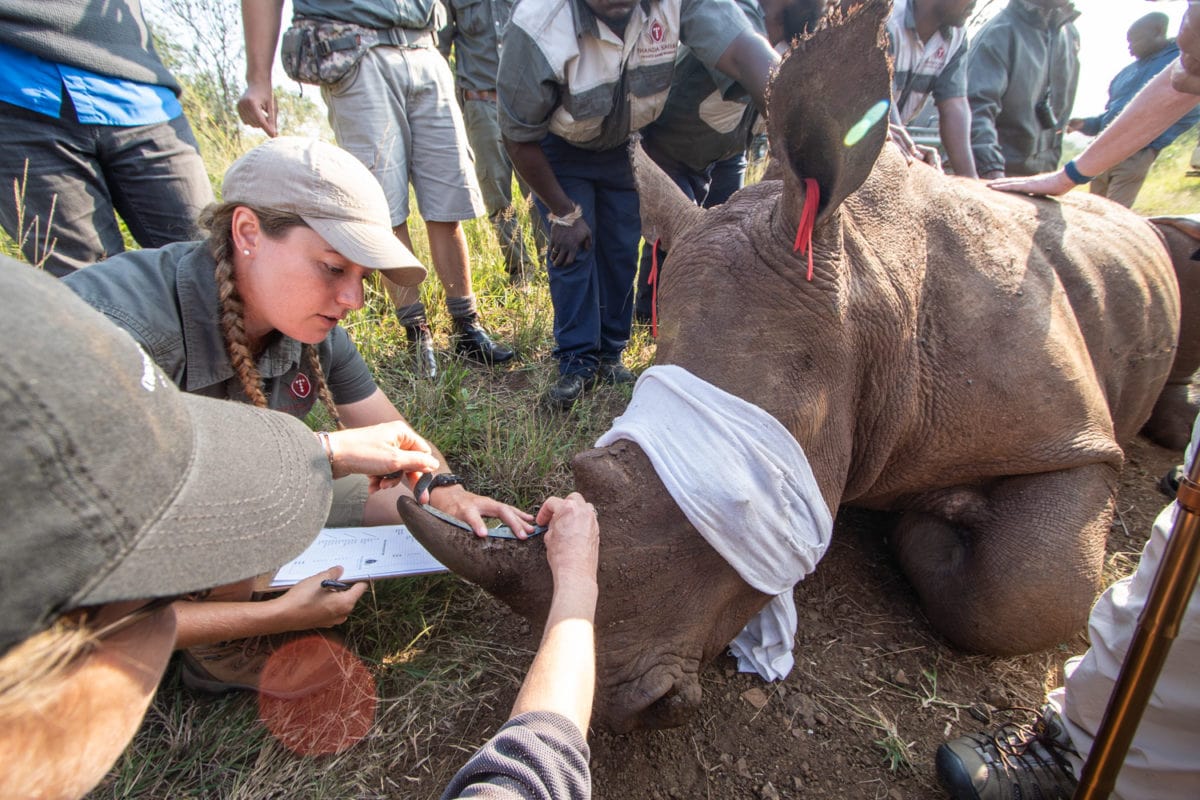

By John Flemming August 29, 2019 - 2:58 am
Love to Read Your Blog. Thanks For Sharing this About Rhinos.
By Maharaja Express August 29, 2019 - 8:48 am
wow! that is an awesome place and it is full with beautiful things. You shared amazing experience of that place and so stunning photos you shared.
By Judy Steiger September 6, 2019 - 12:32 pm
After reading this post, I felt pretty the same—now I better understand the problem but have no better solution, except travelling. Thank you for sharing this.
Recently I’ve also read a similar article about whales. Some countries are still involved in illegal whaling, and whale watching is a thousand times better alternative of making money.
We are capable of making this world a better place to live in.
By Ioana Stoica October 3, 2019 - 12:08 pm
Thanks for writing this and explaining this issue in such great depth. I hope for a time when we talk about rhinos population rebounding and not diminishing. Very thought-provoking. Thanks again.